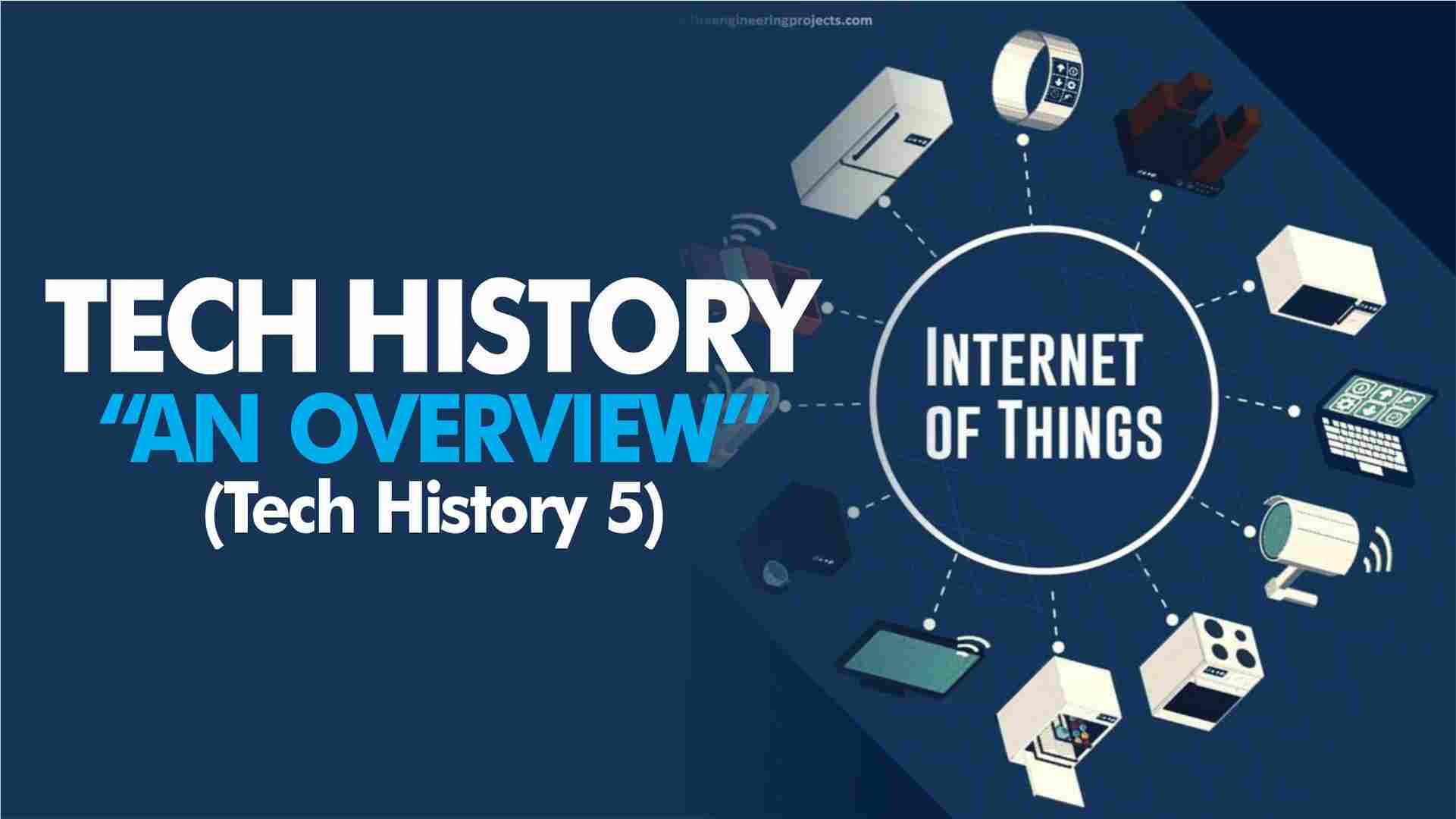Tech History (An Overview) 5

Hi guys! How’s it hanging at your end‽ Still on Tech History (Unveiling the Fascinating Evolution of Tech History: A Comprehensive but Synoptic Guide) Let’s pick it up where we left off.
PS: If you haven’t read the prequels, please do.
Let’s get right to it!
Tech History
IV. Internet of Things (IoT): Connecting the World
The Internet of Things (IoT) has emerged as a revolutionary concept, transforming the way we interact with everyday objects and enabling a seamless flow of information. By connecting devices and objects to the internet, IoT has opened up new possibilities for automation, data collection, and analysis. This article explores the fundamentals of IoT and its potential to transform our lives.
Understanding the Fundamentals of IoT:
At its core, the Internet of Things refers to the network of physical devices, vehicles, appliances, and other objects embedded with sensors, software, and connectivity capabilities that allow them to connect and exchange data. These devices, often referred to as “smart” devices, can collect and transmit data, interact with other devices or systems, and be remotely controlled or monitored.
Key Technologies Driving IoT:
- Sensors and Actuators: IoT devices rely on sensors to collect data from the environment. These sensors can measure temperature, humidity, light, motion, and various other parameters. Actuators, on the other hand, enable IoT devices to perform physical actions based on the data received.
- Connectivity: IoT devices utilize different communication technologies to connect to the internet, such as Wi-Fi, Bluetooth, cellular networks, and Low-Power Wide-Area Networks (LPWAN). These connectivity options ensure seamless data exchange between devices and enable remote access and control.
- Data Analytics: The enormous amount of data generated by IoT devices is processed and analyzed to extract meaningful insights. Advanced analytics techniques, including machine learning and artificial intelligence, help identify patterns, detect anomalies, and make informed decisions based on the collected data.
Transforming Our Lives:
- Smart Homes: IoT enables homeowners to automate and control various aspects of their homes. From remotely managing lighting, heating, and security systems to monitoring energy consumption, IoT enhances convenience, comfort, and energy efficiency.
- Healthcare: IoT has the potential to revolutionize healthcare by enabling remote patient monitoring, real-time health data collection, and personalized treatment plans. Wearable devices, such as fitness trackers and smartwatches, can track vital signs and provide valuable health insights to individuals and healthcare professionals.
- Transportation: IoT plays a crucial role in the development of smart transportation systems. Connected vehicles can communicate with each other and infrastructure, improving road safety, optimizing traffic flow, and reducing fuel consumption. Additionally, IoT can facilitate logistics and fleet management, leading to cost savings and operational efficiency.
- Industrial Automation: IoT is reshaping industries by enhancing automation and efficiency. In manufacturing, IoT-powered sensors can monitor machine performance, detect faults, and enable predictive maintenance. This minimizes downtime, increases productivity, and reduces costs.
- Agriculture: IoT solutions in agriculture, often referred to as precision farming or smart agriculture, enable farmers to monitor and optimize crop conditions, soil moisture, and livestock health. This data-driven approach promotes sustainable farming practices, minimizes resource waste, and increases crop yields.

Challenges and Considerations:
While the IoT brings numerous benefits, several challenges must be addressed for its widespread adoption. Security and privacy concerns are paramount, as a large-scale deployment of connected devices increases the potential attack surface. Standardization, interoperability, and data governance also require attention to ensure seamless integration and data sharing across different IoT ecosystems.
The Internet of Things has emerged as a transformative concept, connecting everyday objects to the Internet and enabling a seamless flow of information. From smart homes to healthcare, transportation, industrial automation, and agriculture, IoT has the potential to revolutionize various aspects of our lives. However, addressing security, privacy, and standardization challenges will be crucial for unleashing the full potential of IoT and ensuring a connected future that benefits us all.
Furthermore, let us extend beyond the upper chunk and, through real-world examples, explore how IoT is being applied in sectors such as healthcare, transportation, and smart cities, as well as discuss the challenges and considerations associated with a fully connected world, including privacy, security, and the ethical implications of IoT technology.
IoT in Healthcare:
IoT technology has significantly impacted the healthcare sector, enabling remote patient monitoring, improving diagnostics, and enhancing patient care.
- Remote Patient Monitoring: IoT devices such as wearable sensors, smart medical devices, and mobile health applications allow healthcare providers to remotely monitor patients’ vital signs, collect real-time health data, and provide personalized care. This technology is particularly beneficial for managing chronic conditions, post-operative care, and elderly patient monitoring.
- Smart Medical Devices: IoT-enabled medical devices, such as insulin pumps, pacemakers, and continuous glucose monitors, can transmit critical patient data directly to healthcare providers, ensuring timely intervention and reducing the risk of complications.
- Telemedicine: IoT facilitates remote consultations and telemedicine services by connecting patients and doctors through video conferencing and data-sharing platforms. Patients can receive medical advice, share symptoms, and even undergo virtual examinations, eliminating the need for in-person visits, especially in rural or underserved areas.
IoT in Transportation:
The transportation sector has embraced IoT technology, transforming how we navigate, commute, and manage logistics.
- Connected Vehicles: IoT-enabled vehicles can communicate with each other, traffic lights, and infrastructure to optimize traffic flow, enhance road safety, and reduce congestion. Vehicle-to-vehicle (V2V) and vehicle-to-infrastructure (V2I) communication enable real-time data exchange, leading to more efficient transportation systems.
- Fleet Management: IoT helps monitor and manage fleet operations efficiently. By equipping vehicles with sensors and GPS tracking, companies can track vehicle locations, optimize routes, monitor fuel consumption, and schedule maintenance, reducing costs and increasing operational efficiency.
- Smart Parking: IoT-based parking systems use sensors and real-time data to guide drivers to available parking spaces, reducing congestion and alleviating the frustration associated with finding parking in urban areas.
IoT in Smart Cities:
Smart city initiatives leverage IoT technology to improve urban living, sustainability, and resource management.
- Energy Management: IoT-enabled sensors and devices can monitor and control energy consumption in buildings, streetlights, and infrastructure. This data-driven approach allows for optimized energy usage, reduces wastage, and enhances sustainability.
- Waste Management: IoT-based waste management systems employ sensors to monitor garbage levels in bins, optimizing waste collection routes and schedules. This reduces costs, minimizes overflowing bins, and improves overall cleanliness in cities.
- Public Safety: IoT technology enhances public safety through surveillance systems, emergency response mechanisms, and predictive analytics. Connected cameras, sensors, and data analysis can help detect and respond to incidents, reduce crime rates, and improve emergency services.
Challenges and Considerations:
As we embrace a fully connected world through IoT, several challenges and considerations must be addressed:
- Privacy and Security: IoT devices collect vast amounts of personal data, raising concerns about data privacy and security. Safeguarding data and ensuring secure communication protocols are crucial to protect individuals’ privacy and prevent data breaches.
- Data Governance: Managing and analyzing the massive volume of data generated by IoT devices requires robust data governance frameworks. Ensuring data ownership, consent, and responsible data use are essential for maintaining trust and addressing ethical concerns.
- Interoperability and Standards: IoT devices and systems often come from different manufacturers and use diverse communication protocols. Establishing interoperability standards is necessary to enable seamless data exchange and integration between devices and platforms.
- Ethical Implications: IoT raises ethical considerations, such as the potential misuse of data, algorithmic biases, and the impact on employment. Addressing these concerns requires ethical frameworks, regulations, and responsible design practices.
Conclusively, IoT has transformed sectors like healthcare, transportation, and smart cities, offering numerous benefits and opportunities. Remote patient monitoring, connected vehicles, and smart city initiatives have revolutionized the way we live, commute, and access healthcare services. However, challenges related to privacy, security, data governance, interoperability, and ethical implications must be addressed to ensure a connected world that prioritizes individual rights, security, and societal well-being. By adopting responsible practices, regulations, and standards, we can harness the full potential of IoT while safeguarding privacy, security, and ethical considerations.
We’ll stop here to pick it up where we left off in the following article. Do let me know your thoughts in the comment section below.
If you are looking to get an excellent web design company, do click here!
For more reads, click on here.




